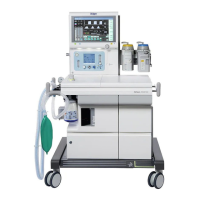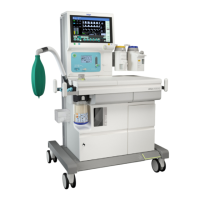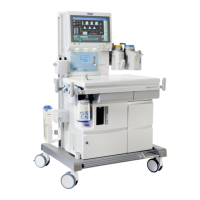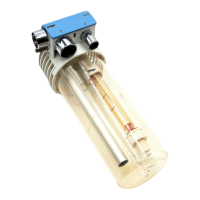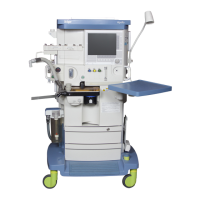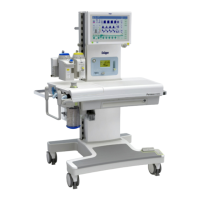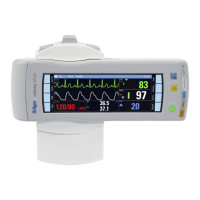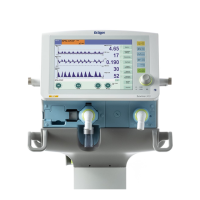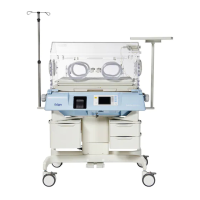
Do you have a question about the Dräger Atlan A350 XL and is the answer not in the manual?
| Brand | Dräger |
|---|---|
| Model | Atlan A350 XL |
| Category | Medical Equipment |
| Language | English |
Describes the device's purpose for anesthetizing patients and its basic ventilation functions and options.
Specifies the device's suitability for inhalational anesthesia and patient ventilation during surgical or diagnostic interventions.
States there are no product-specific contraindications but emphasizes user responsibility for patient condition and safety.
Outlines critical functions like O2 supply, breathing gas supply, and gas measurement that ensure correct operation.
Defines user groups (clinical, reprocessing, service) and the operating organization's duties for safe use.
Provides general instructions for safe use, symbol explanations, and patient condition monitoring requirements.
Covers critical safety precautions related to hoses, filters, cables, breathing bags, electrical safety, and explosion protection.
Details essential steps before initial use, including O2 sensor insertion, mains power connection, and battery charging.
Instructs on correctly connecting central gas supplies and gas cylinders, emphasizing safety and integrity checks.
Emphasizes the importance of checking safety systems regularly during start-up to prevent device malfunction and ensure patient safety.
Provides a step-by-step guide for powering on the device after reprocessing and assembly, including a caution about condensed water.
Details how to interpret standby page colors to confirm system test success and device readiness, and how to view device status.
Provides instructions for emergency start-up procedures for both electronically and mechanically controlled gas mixers.
Covers critical safety aspects including alarm volume, recognizing alarms, impaired Infinity ID functions, and therapy considerations.
Guides users on initiating therapy through quick start or normal start with customized settings, including patient data loading.
Explains how to adjust therapy parameters like the APL valve, fresh-gas delivery, and ventilation settings, including using O2 flush.
Explains how to set alarm limits manually or automatically, activate/deactivate CO2 alarms, and manage automatic xMAC monitoring.
Describes how to check device function status and interpret test results displayed with color codes indicating operational status.
Lists and describes the types of tests available, including System test and Leakage test, with their durations and purposes.
Provides detailed procedures for performing system tests and leakage tests, including prerequisites and steps for tabular or walk-through modes.
Covers critical safety aspects related to alarm volume, recognition, and potential issues with Infinity ID components.
Explains how alarms are signaled optically and acoustically during therapy and standby modes, and how to view alarm details.
Details how to display alarm information, silence alarms, downgrade priorities, and acknowledge alarm messages.
Identifies possible causes of leakage in the system and provides systematic methods for localization and automatic compensation.
Addresses issues related to mains power failure and battery discharge, explaining device behavior and available functions.
Details malfunctions caused by central supply failure or one gas failure, including substitute gas usage and cylinder replacement.
Explains how to manage fresh-gas delivery failure using emergency O2 delivery and provides troubleshooting steps.
Addresses O2 sensor failure, including risks, calibration issues, and replacement procedures.
Outlines steps for device failure, including activating backup mode, ventilating manually, and using a substitute device.
Provides a comprehensive table listing alarms, their causes, remedies, priorities, and background colors for troubleshooting.
Covers essential safety measures for reprocessing reusable and disposable products, emphasizing infection prevention.
Emphasizes safety during service activities, including intervals, implementation, housing hazards, and reprocessing requirements.
Highlights infection risks associated with improper reprocessing and emphasizes the need for reprocessing before servicing, return, or disposal.
Covers safety measures related to electromagnetic compatibility (EMC), electrostatic discharge, and electromagnetic disturbances.
Details EMC requirements, emissions, compliance, immunity test levels, and recommended separation distances from communication devices.
Emphasizes safety when using Infinity ID components, including checking accessories, connections, and performing leakage tests.
Explains the meaning and function of various therapy controls and ventilation modes like PC, VC, SIMV, and PSV.
Provides information on the configuration password for preventing unauthorized alteration of start settings, including how to cut it out.

